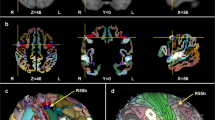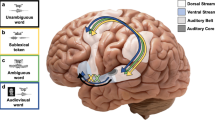Abstract
The neuronal system to process and transfer auditory information to the higher motor areas was investigated using fMRI. Two different types of internal modulation of auditory pacing (1 Hz) were combined to design a 2×2 condition experiment, and the activation was compared with that under a visual guidance. The bilateral anterior portion of the BA22 (ant-BA22) and the left BA41/42 were more extensively activated by the combined modulation condition under the auditory cue than that under the visual cue. Among the four auditory conditions with or without the two types of internal modulation, the activation in the ant-BA22 was augmented only on the left side by the combined modulation condition. The left ant-BA22 may be especially involved in integrating the external auditory cue with internal modulation, while the activation on the right side did not depend on the complexity. The role of the left BA41/42 in motor regulation may be more specific to the processing of an auditory cue than that on the right side. These two areas in the left temporal lobe may be organized as a subsystem to handle the timing of complex movements under auditory cues, while the higher motor areas in the frontal lobe support both sensory modalities for the cue. This architecture may be considered as ‘audio-motor control’, which is similar to the visuo-motor control of the front-parietal network.



Similar content being viewed by others
Explore related subjects
Discover the latest articles, news and stories from top researchers in related subjects.References
Brooks DJ (1995) The role of the basal ganglia in motor control: contributions from PET. J Neurol Sci 128:1–13
Church RM (2003) Time perception. In: Nadel L (ed) Encyclopedia of cognitive science. Nature Publishing Group, London, pp 398–400
Dhamala M, Pagnoni G, Wiesenfeld K, Zink CF, Martin M, Berns GS (2003) Neural correlates of the complexity of rhythmic finger-tapping. Neuroimage 20:918–926
Fogassi L, Gallese V, di Pellegrino G, Fadiga L, Gentilucci M, Luppino G, Matelli M, Pedotti A, Rizzolatti G (1992) Space coding by premotor cortex. Exp Brain Res 89:686–690
Glover GH, Lai S (1998) Self-navigated spiral fMRI: interleaved versus single-shot. Magn Reson Med 39:361–368
Goldberg G (1985) Supplementary motor area structure and function: review and hypotheses. Behav Brain Sci 8:567–615
Grafton ST, Fagg AH, Woods RP, Arbib MA (1996) Functional anatomy of pointing and grasping in humans. Cerebral Cortex 6:226–237
Graziano MSA, Hu XT, Gross CG (1997) Visuospatial properties of ventral premotor cortex. J Neurophysiol 77:2268–2292
Harrington DL, Haaland KY, Hermanowicz N (1998) Temporal processing in the basal ganglia. Neuropsychology 12:3–12
Hatta T (1996) Neuropsychology of left-handedness. Ishiyaku Publishers, Tokyo
Ivry RB (1996) The representation of temporal information in perception and motor control. Curr Opin Neurobiol 6:851–857
Jäncke L, Loose R, Lutz K, Specht K, Shah NJ (2000) Cortical activations during paced finger-tapping applying visual and auditory pacing stimuli. Cogn Brain Res 10:51–66
Jantzen KJ, Steinberg FL, Kelso JAS (2002) Practice-dependent modulation of neural activity during human sensorimotor coordination: a functional magnetic resonance imaging study. Neurosci Lett 332:205–209
Krams M, Rushworth MFS, Deiber MP, Frackowiak RSJ, Passingham RE (1998) The preparation,execution and suppression of copied movements in the human brain. Exp Brain Res 120:386–398
Mayville JM, Jantzen KJ, Fuchs A, Steinberg FL, Kelso JAS (2002) Cortical and subcortical networks underlying syncopated and synchronized coordination revealed using fMRI. Hum Brain Mapp 17:214–229
Nakai T, Kato C, Glover GH, Toma K, Moriya T, Matsuo K (2003) A functional magnetic resonance imaging study of internal modulation of an external visual cue for motor execution. Brain Res 968:238–247
Penhune VB, Zatorre RJ, Evans AC (1998) Cerebellar contributions to motor timing: a PET study of auditory and visual rhythm reproduction. J Cogn Neurosci 10:752–765
Rao SM, Harrington DL, Haaland KY, Bobholz JA, Cox RW, Binder JR (1997) Distributed neural systems underlying the timing of movements. J Neurosci 17:5528–5535
Riecker A, Wildgruber D, Dogil G, Grodd W, Ackermann H (2002) Hemispheric lateralization effects of rhythm implementation during syllable repetitions: an fMRI study. 16:169–176
Rushworth MFS, Krams M, Passingham RE (2001) The attentional role of the left parietal cortex: The distinct lateralization and localization of motor attention in the human brain. J Cogn Neurosci 13:698–710
Schubotz RI, Friederici AD, von Cramon DY (2000) Time perception and motor timing: a common cortical and subcortical basis revealed by fMRI. Neuroimage 11:1–12
Tanji J (1996) New concepts of the supplementary motor area. Curr Opin Neurobiol 6:782–787
Van Oostende S, Van Hecke P, Sunaert S, Nuttin B, Marchal G (1997) FMRI studies of the supplementary motor area and the premotor cortex. Neuroimage 6:181–190
Wise SP, Boussaoud D, Johnson PB, Caminiti R (1997) Premotor and parietal cortex: corticocortical connectivity and combinatorial computations. Annu Rev Neurosci 20:25–42
Zatorre RJ, Belin P (2001) Spectral and temporal processing in human auditory cortex. Cereb Cortex 11:946–953
Zatorre RJ, Binder JR (2000) Functional and structural imaging of the human auditory system. In: Toga AW, Mazziotta JC (ed) Brain mapping the systems. Academic Press, San Diego, pp 365–402
Author information
Authors and Affiliations
Corresponding author
Rights and permissions
About this article
Cite this article
Nakai, T., Matsuo, K., Ohgami, Y. et al. An fMRI study of temporal sequencing of motor regulation guided by an auditory cue—a comparison with visual guidance. Cogn Process 6, 128–135 (2005). https://doi.org/10.1007/s10339-005-0051-5
Received:
Revised:
Accepted:
Published:
Issue Date:
DOI: https://doi.org/10.1007/s10339-005-0051-5




